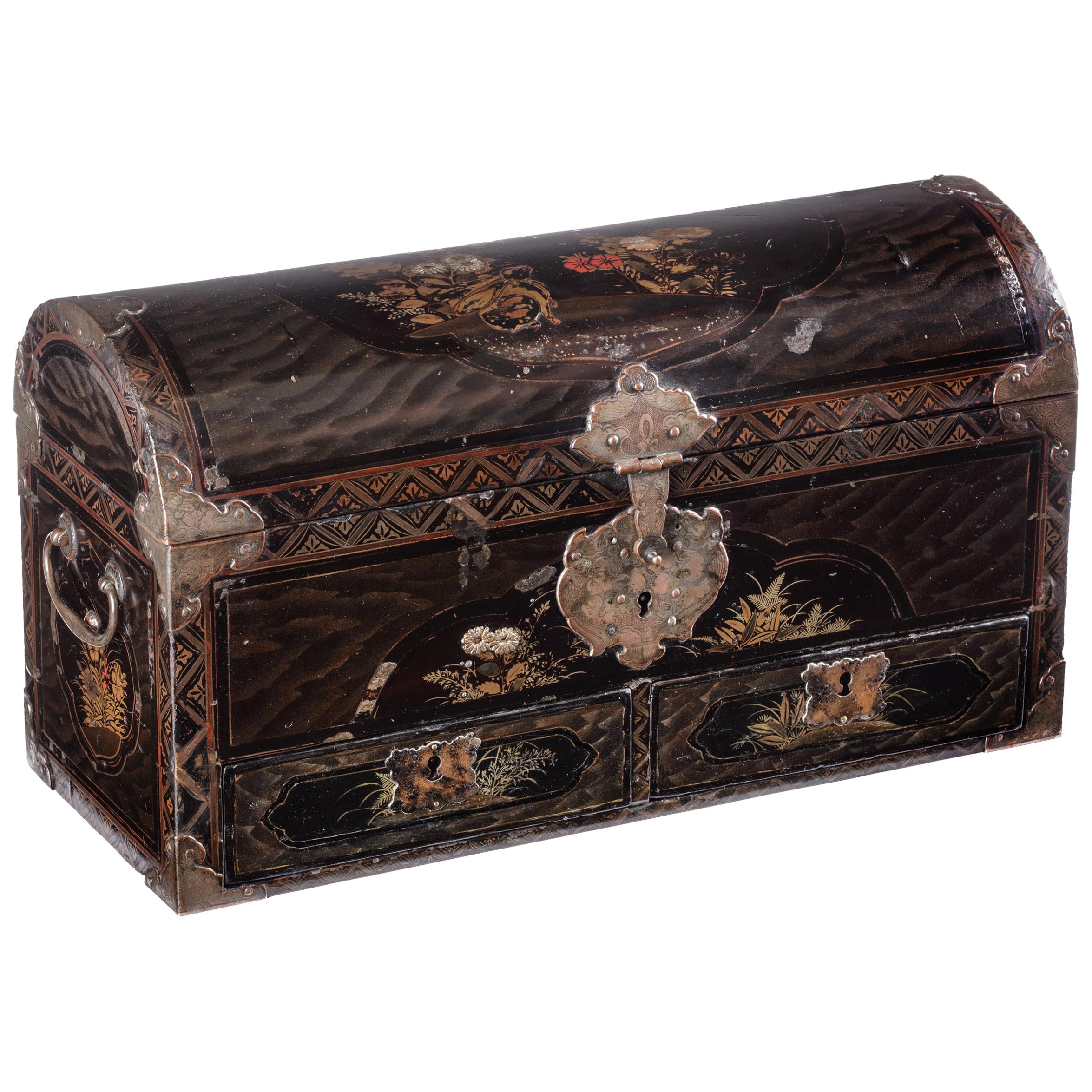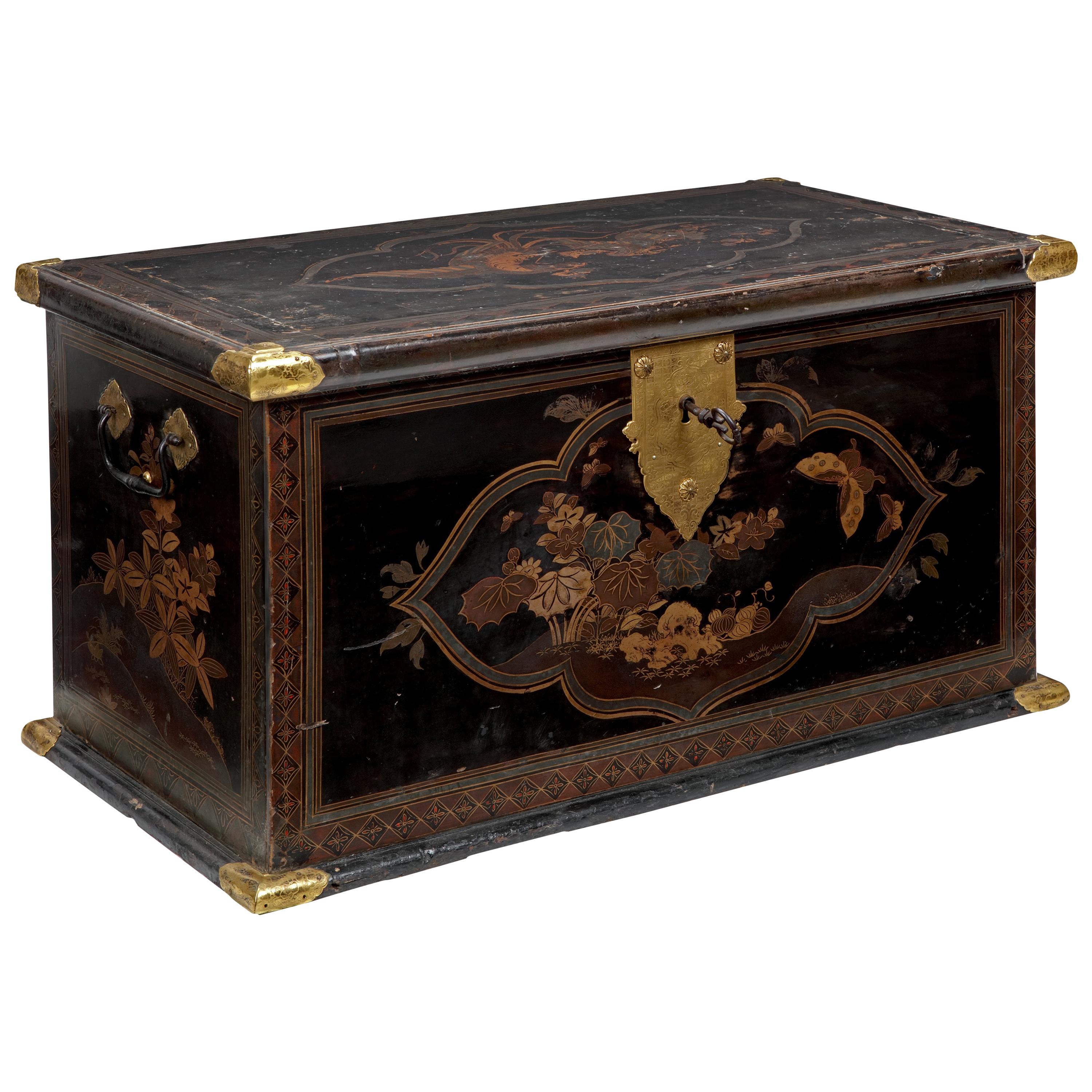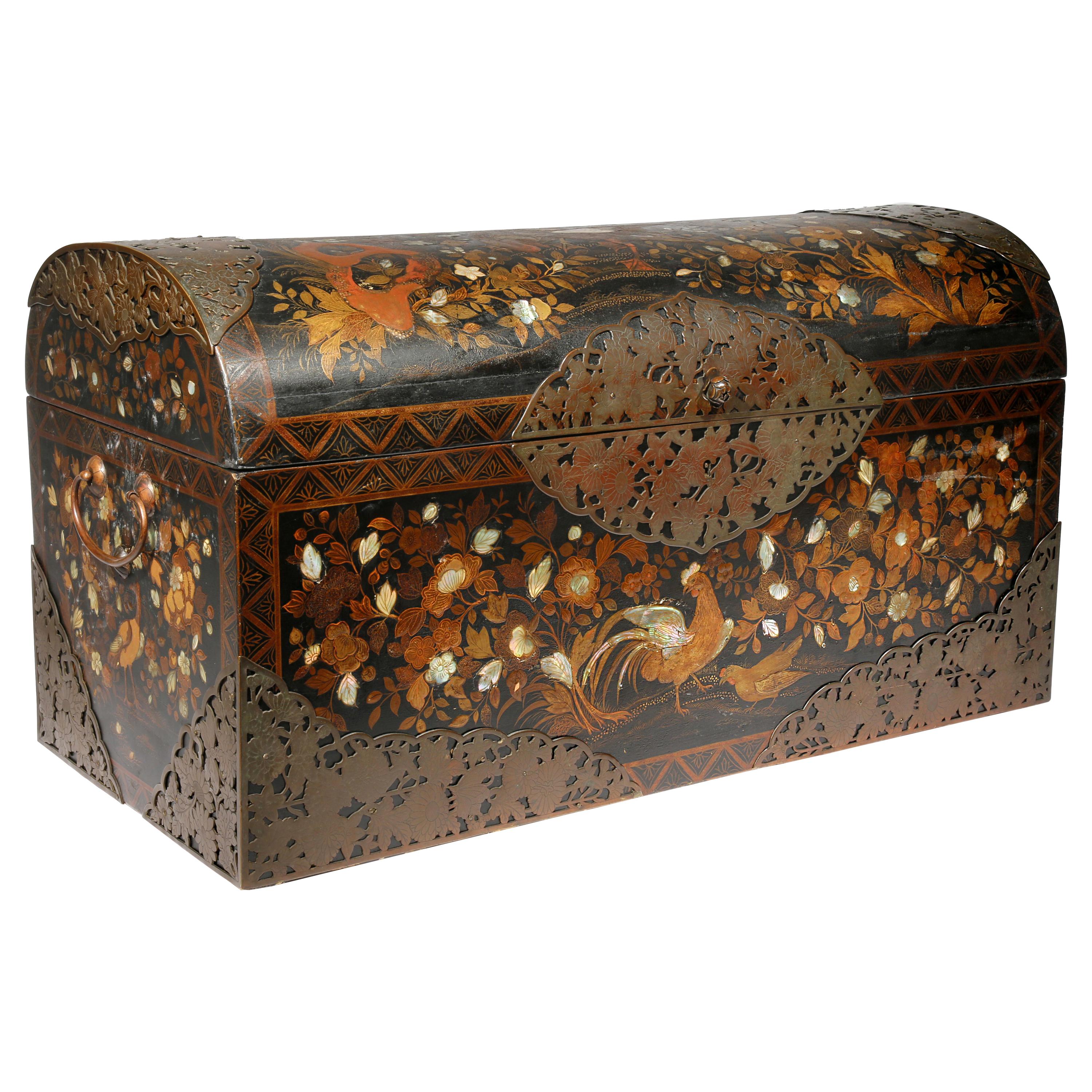Items Similar to 17th-Century Japanese Namban Lacquer Coffer on French Stand, Possibly by Boulle
Want more images or videos?
Request additional images or videos from the seller
1 of 5
17th-Century Japanese Namban Lacquer Coffer on French Stand, Possibly by Boulle
About the Item
An impressive and large Japanese 'Namban' transition-style lacquer coffer with fine gilt copper mounts on a French Re´gence base, possibly by André-Charles Boulle (1642-1732)
Kyoto, 1640-1650, the base 18th century
?The coffer with shaped cartouches on a nashiji ground on the lid, front and sides, with fine decorations in various techniques: takimaki-e (high relief), tsuke-gaki (drawing with narrow lacquer lines and over sprinkling with gold and silver), usuniku-takamei-e (demi relief), kimekomi (pushed inside) and accents of kirigane (small geometrical metal mosaics). Inside the cartouche on the lid a landscape with volcanos, at their feet temples and around their summits clouds. Inside the cartouche of the front a hilly landscape with trees, huts and two cows at a waterside, under clouds. The cartouches at the sides show autumn grasses, chrysanthemum and campanula, and the back is decorated with trails of clematis. The black lacquered and gilt mounts showing a mom, a Japanese family coat of arms, are quite similar to the black and gilt mounts of the Mazarin coffer in the V&A museum (inv. 412:1-1882) and the recently acquired coffer in the Rijksmuseum (inv. AK-RAK-2013-3-1).
Coffer: L. 132.7 x H. 62.8 x D. 59.3 cm
Stand: L. 143.7 x H. 51 x D. 71.9 cm
After the five-year lapse in trade with Japan as a result of the Taiwan Incident (see number 44 in Uit Verre Streken, November 2021, a woodblock print depicting the capture of Pieter Nuyts, the Dutch governor of Formosa/Taiwan, by Japanese sea captains in 1628), in 1633 ordering of Japanese lacquer by the VOC as well as by private trade seriously took off. Attempts by the VOC to prevent private trade were largely unsuccessful. Private traders were quicker, got the better pieces and often for better prices than the VOC which had to rely on officials whom themselves traded privately. It was not difficult for Dutch clients outside Japan, having the right connections with VOC officials in the Netherlands or Batavia, or even directly through merchants on Deshima, to buy Japanese lacquer. By its nature, private trade is rather elusive, usually lacking written documents such as letters, orders or invoices. Much private trade dealt in the same objects the Company bought, so these pieces can not be distinguished. Whether the present coffer was ordered by the VOC or by a private trader therefore can not be decided. By the end of the 17th century, because of complaints about the prices and the quality of the lacquer offered by the VOC, the Company decided to stop trading in lacquer altogether in 1693. Successful private trade in lacquer continued though.
- Dimensions:Height: 44.81 in (113.8 cm)Width: 56.58 in (143.7 cm)Depth: 28.31 in (71.9 cm)
- Materials and Techniques:
- Place of Origin:
- Period:
- Date of Manufacture:1640-1650, 18th Century
- Condition:Repaired: The coffer has been professionally restored at the usual places. Borders and the lid have been partially restored in Japanese lacquer techniques. Borders are often damaged due to minor chips of daily usage, and the lid often because it was cleaned. Wear consistent with age and use.
- Seller Location:Amsterdam, NL
- Reference Number:1stDibs: LU5458229633272
About the Seller
5.0
Vetted Seller
These experienced sellers undergo a comprehensive evaluation by our team of in-house experts.
Established in 1985
1stDibs seller since 2020
19 sales on 1stDibs
Typical response time: 3 hours
- ShippingRetrieving quote...Ships From: Amsterdam, Netherlands
- Return PolicyA return for this item may be initiated within 7 days of delivery.
More From This SellerView All
- Fine Japanese Namban Lacquer Jewelry Casket, 17th CenturyLocated in Amsterdam, NLJapanese Namban lacquer transition-style coffer with two drawers Kyoto/Nagasaki, circa 1650 The cartouches with gilt and red decorations of leaves...Category
Antique 17th Century Japanese Edo Lacquer
MaterialsCypress
- Large Royal Early 17th Century Japanese Lacquer Chest with Gilt-Bronze MountsLocated in Amsterdam, NLA large Japanese transitional lacquer chest with gilt-metal mounts Edo period, early 17th century The rectangular chest with flat hinged lid decorated in gold, silver, and red ...Category
Antique Early 17th Century Japanese Blanket Chests
MaterialsBronze
- Large Japanese Namban Lacquer Coffer Arqueta, 16th CenturyLocated in Amsterdam, NLA large Japanese Namban lacquer arqueta coffer for the Portuguese market Kyoto, Momoyama-period, late 16th century In Hinoki cypress lacquered in ...Category
Antique 16th Century Japanese Decorative Boxes
MaterialsMother-of-Pearl, Wood
- Unique 17th Century Miniature Japanese Namban Lacquer Miniature Dollhouse ChestLocated in Amsterdam, NLA unique and exceptional Japanese miniature or dollhouse export lacquered chest Kyoto, circa 1620-1640 The chest of rectangular shape with a domed lid, decorated in Transition-style, in gold hiramaki-e on a black background within reserved lobed cartouches decorated with landscapes animated with birds and rabbits, on a shagreen or samegawa background. The borders are decorated with geometric friezes, the box with gilt-copper mounts, the interior decorated in red lacquer. Measures: H 9.2 x W 14.5 x D 7.2 cm This miniature is of exceptional quality and a perfect copy of the famous large size Transition-style coffers. It was most likely ordered by a Dutch lady for her dollhouse (poppenhuis), like the famous Petronella Oortman (1656-1716) doll-house, which is now one of the highlights in the collection of the Rijksmuseum Amsterdam, or Petronella Oortmans-de la Court’s (1624-1707) dollhouse in the collection of the Centraal Museum Utrecht. Sara Rothé of Amsterdam in 1743 ordered a miniature black lacquered ivory tripod table with gold chinoiserie decoration by Jurriaan Buttner (Monika Kopplin, European Lacquer, 2010, p. 56). Other Japanned dollhouse...Category
Antique 17th Century Japanese Edo Lacquer
MaterialsShagreen, Cypress
- Superb Late 16th Century Signed Colonial Japanese Namban Export Lacquer CofferLocated in Amsterdam, NLSuperb late 16th century signed colonial Japanese Namban export lacquer coffer Momoyama period, late 16th/early 17th century, inscribed 'Arisato' on the bottom H. 30.5 x W. 43...Category
Antique 16th Century Japanese Lacquer
MaterialsCedar, Lacquer
- A rare Japanese Namban export lacquer coffer with Mon emblemsLocated in Amsterdam, NLLate Momoyama period, late 16th century The coffer is decorated in black lacquer, urushi, on cedar wood, decorated with gold dust and silver, maki-e, and nashiji, mother-of-pearl, r...Category
Antique 16th Century Japanese Lacquer
MaterialsSilver, Copper
You May Also Like
- 17th Century Japanese Negoro Style Lacquered StandLocated in Fukuoka, JPA Rare Negoro Lacquer Buddhist Stand This rare and historic Negoro lacquer Buddhist stand is a beautiful example of Japanese craftsmanship. It is made of wood with Negoro-style lacq...Category
Antique 17th Century Japanese Lacquer
MaterialsWood, Lacquer
- Japanese Namban Lacquer and Inlay Coffer Momoyama PeriodLocated in Atlanta, GAA rare Japanese Namban Lacquer domed coffer circa 1570-1610s of Azuchi-Momoyama to early Edo period. These types of lacquerware were made for export to ...Category
Antique 16th Century Japanese Japonisme Lacquer
MaterialsWood, Lacquer
- Japanese Lacquered Karabitsu TrunkLocated in New York, NYJapanese (19th Cent) brown lacquered karabitsu traveling trunk with carved birds and floral relief of gilt and pearl inlay resting on 6 legs.Category
Antique 19th Century Lacquer
MaterialsLacquer
- Chinese 19th Century Qing Dynasty Red Lacquered Blanket Chest with Iron HardwareLocated in Yonkers, NYA Chinese Qing dynasty period red lacquered blanket chest from the 19th century, with iron hardware. This exquisite Chinese Qing dynasty period blanket chest, dating back to the 19th...Category
Antique 19th Century Chinese Qing Blanket Chests
MaterialsIron
- Japanese Lacquered Basin with Ear-Shaped Handles 'Mimidarai', 17th CenturyLocated in Milano, ITWooden basin with ear-shaped handles decorated with hiramaki-e lacquer and gold and silver kirigane on a nashi-ji ground. The large and thick antique woo...Category
Antique 17th Century Japanese Lacquer
MaterialsWood
- Japanese Lacquer Display Cabinet on Stand, Meiji Period, 19th Century, JapanLocated in Austin, TXA spectacular Japanese lacquer and porcelain inlaid display cabinet on stand, kazaridana, Meiji Period, late 19th century, Japan. The sumptuous kazaridana of traditional display cabinet form, with several shelves and enclosed spaces for display and storage. The cabinet decorated all over in beautiful maki-e lacquer against a dense nashiji ground and inset with blue and white Arita porcelain plaques. The front of the cabinet of asymmetric design, with two open display shelves at staggered heights, and several doors enclosing storage areas of various shapes and sizes, including one hinged corner door, two pairs of sliding doors, and one pair of hinged doors opening to reveal a rounded inset corner shelf. A pair of drawers below complete the cabinet. All supported on a separate tall fitted stand. The corner door decorated with a bold scene of a samurai warrior fighting a demon. This most likely depicts the warrior Watanabe no Tsuna battling the demon Ibaraki-doji at Rashomon gate, in which Watanabe no Tsuna attempts to help a young girl return home, carrying her on his back, only for the girl to turn into a demon, which he then must fight. The top pair of sliding doors with a scene of a man playing the sho, a Japanese mouth organ, along the banks of a river with a waterfall in the background. The bottom pair of sliding doors with a waterfall scene on one side, while a scholar lounges with his attendants on the other. The pair of hinged doors finely decorated with a pair of fully armored samurai. The two drawers wonderfully decorated in the kodaiji style with a stream of rushing water and various plants and grasses. The cabinet is decorated in the round, with the top, sides, and base of the cabinet decorated with various scenes of flowers and birds, and inset with blue and white Arita porcelain plaques in the form of traditional fan. The fans painted...Category
Antique 1880s Japanese Meiji Lacquer
MaterialsPorcelain, Softwood, Lacquer
Recently Viewed
View AllMore Ways To Browse
Lacquered Brass
Lacquered Base
French Lacquer
French Furniture Lacquered
Black Lacquer Brass Furniture
Black Lacquer Brass
Black Lacquer And Brass
Black Lacquered And Brass
Prices On Antique Furniture
Black Lacquer French
Black Lacquer Sides
French Wood Lacquer
Lacquer Company
Black Gold Lacquer
Gold And Black Lacquer
The Lacquer Company
Stand Japan
Asian On Stand





